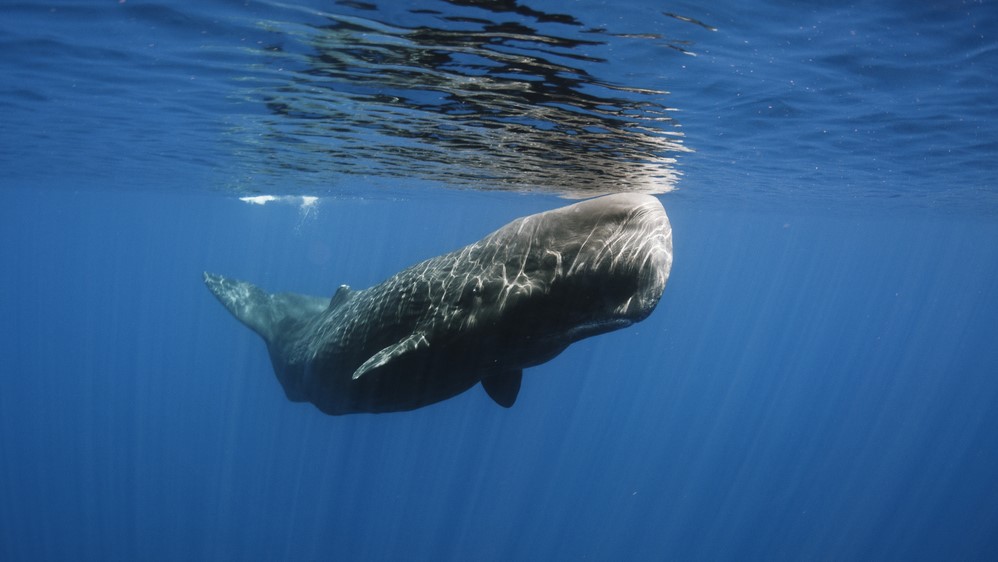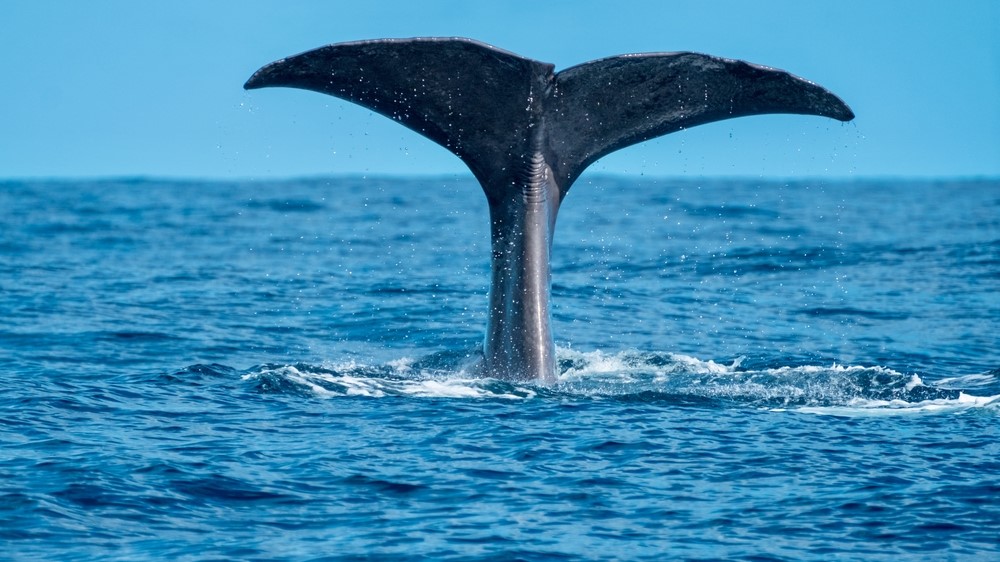Real-life Moby Dick spotted off the coast of Jamaica
The white sperm whale was spotted by sailors aboard a gas tanker.
A rare white sperm whale, like the one depicted in the literary classic "Moby Dick," has been spotted off the coast of Jamaica.
Sailors aboard the Dutch oil tanker Coral EnergICE glimpsed the ghostly cetacean on Nov. 29, when Capt. Leo van Toly recorded a short video highlighting a brief look at the white sperm whale near the water's surface. He sent the video to his sailing partner, Annemarie van den Berg, director of the whale conservation charity SOS Dolfijn in the Netherlands. After confirming with experts that the whale was indeed a sperm whale, SOS Dolfijn shared the video on the organization's Facebook page.
In Herman Melville's famous novel, Moby Dick is a monstrous white sperm whale hunted by the vengeful Captain Ahab, who lost his leg to the toothed whale. The book is narrated by the sailor Ishmael, who famously said, "It was the whiteness of the whale that appalled me," when referring to its paleness. Although Moby Dick was fictional, white sperm whales are real. Their whiteness is the result of either albinism or leucism; both conditions impact the whales' ability to produce the pigment melanin, which is responsible for their normal gray color.
Related: In photos: A rare albino Risso's dolphin
"We don't know how rare white sperm whales are," Shane Gero, a sperm whale expert at Dalhousie University in Canada and founder of the Dominica Sperm Whale Project, told Live Science in an email. "But they do get seen from time to time."
Because the ocean is so expansive, scientists are unsure how many white sperm whales exist, Gero said. Sperm whales (Physeter macrocephalus) are also extremely elusive and hard to study because of their ability to dive deep into the ocean for long periods of time.
"It's easy for a whale to hide, even one that is as long as a school bus," Gero said. "So even if there were many white sperm whales, we just wouldn't see them very often."
Get the world’s most fascinating discoveries delivered straight to your inbox.
The last documented sighting of a white sperm whale occurred in 2015 off the Italian island of Sardinia. However, there have also been sightings in Dominica (in the Caribbean) and the Azores (in the Atlantic) in recent years, Gero said. It is possible that the one sighted in Jamaica is the same one from Dominica, but that is unclear, he added.
There are also occasional sightings of white whales among other species (other than belugas, whose normal color is white). An albino humpback whale named Migaloo has been sighted frequently in Australian waters since 1991, according to the Pacific Whale Foundation. And in July, whale watchers in Japan spotted a pair of white killer whales, which were most likely albinos, Live Science reported at the time.
White whales have either albinism or leucism. Albinism is a genetic condition in which an animal cannot produce melanin, a pigment that gives color to skin and hair, resulting in a total lack of color in the affected individual. Leucism is similar but affects melanin production in individual pigment cells, which can cause total or partial color loss. Therefore, whales with leucism can be totally white or have white patches.
Despite potential differences in coloration between albinism and leucism, "there is no way to conclusively tell them apart without genetics," Gero said. Some researchers believe eye color can also distinguish the two conditions, because most albino whales have red eyes, but this is not a guarantee, Gero said.
"The whale in Jamaica is very white, and my guess is it's an albino — but that's just my guess," Gero said.
Critics have long debated the significance of Melville's decision to make Moby Dick white. Some people believe he was criticizing the slave trade, while others claim it was done purely for theatrics, according to The Guardian. However, to Gero, the significance of Moby Dick was not the whale's coloration but the way the book depicts the relationship between humans and sperm whales.
Around the time the book was written in 1851, sperm whales were being hunted across the globe for the highly valuable fats and oils in their blubber, Live Science previously reported. This not only drove the species to the brink of extinction but also pushed humans to develop new sources of energy and the technology associated with them. "If it were not for sperm whales, our industrial age would be very different," Gero said. "Before fossil fuels, these whales powered our economy by making our machines run and lighting up our nights."
Whaling is no longer a serious threat to sperm whales, Gero said, but humans still introduce dangers such as ship strikes, noise pollution, oil spills, plastic pollution and entanglement in fishing gear.
Sperm whales are currently listed as vulnerable to extinction, but their exact numbers and global population trends are poorly understood because of a lack of data, according to the International Union for Conservation of Nature (IUCN).
Originally published on Live Science.

Harry is a U.K.-based senior staff writer at Live Science. He studied marine biology at the University of Exeter before training to become a journalist. He covers a wide range of topics including space exploration, planetary science, space weather, climate change, animal behavior and paleontology. His recent work on the solar maximum won "best space submission" at the 2024 Aerospace Media Awards and was shortlisted in the "top scoop" category at the NCTJ Awards for Excellence in 2023. He also writes Live Science's weekly Earth from space series.





